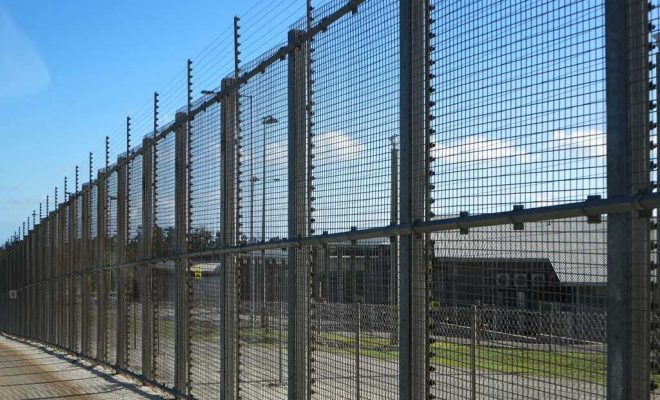 "Detention Center Fencing" courtesy of [David Stanley via Flickr]
"Detention Center Fencing" courtesy of [David Stanley via Flickr]
World
Family Detention Centers: Women and Children Locked up After Fleeing Violence
Refugees fleeing gang violence, blackmail, torture, and murder in Central America hope to end up on U.S. soil after weeks of walking, but of those who make it across the border, many end up in family detention centers for months. Countries such as Honduras, El Salvador, and Guatemala have among the highest homicide rates in the world, according to the UN, and women and children are the most vulnerable. In 2014, over 66,000 children traveling with their mothers fled from Northern Central America to the United States.
What is a family detention center?
At “Beyond the Wall: Women and Children Refugees: A Central American Crisis,” an event hosted by the New York City Bar Association last Tuesday, human rights advocates and health researchers got together to start a dialogue about the complex Central American refugee situation. The discussion focused on a UNHCR study, “Women On the Run,” which was released last October detailing the crisis and its current challenges.
One family detention center in particular, the South Texas Family Residential Center in Dilley, Texas, has gotten a lot of attention from advocates. The Dilley facility is the first family detention center in the United States since the Japanese family centers during World War II. It opened in December 2014 and is the largest in the world–though the term family center may be a bit misleading because men get separated from their families and sent to all-male centers that can be located thousands of miles away. Human rights advocates have reported numerous instances of verbal and physical abuse as well as insufficient food and water for the detainees.
Read More: Mother’s Day Appeal Outside the White House Aims to Abolish Family Detention Centers
"I was just trying to save my son's life" ~ Ada fled violence in #CentralAmerica https://t.co/UUqup2A23o #refugees pic.twitter.com/rtqmKcXxch
— UNHCR Washington (@UNHCRdc) May 20, 2016
Fleeing Violence
The UNHCR’s study, “Women on the Run” details the dangerous situations that women and children in many Central American countries face, forcing many to flee to the United States for safety. These women have been through serious domestic abuse, extortion, death threats, and rape. One of them tells of how she was two months pregnant when her cousin grabbed her and raped her on the street in front of his gang. Many others say that they see dead bodies on the streets daily. It can be the choice between certain death, and risking everything to have a chance of a normal life if granted asylum in the United States.
But even if they make it across the U.S. border, these refugees are not necessarily safe. Many end up in the family detention centers, where the women and children can stay for months without any information about their cases or even when they can talk to lawyera.
Imprisoned for over a year
Ana has spent the longest time in an Immigrations and Customs Enforcement (ICE) family detention–almost 13 months–according to Aseem Mehta, a fellow at Immigration Justice Corps. Her last name is kept secret for legal reasons; her case is still pending. Back in El Salvador she was blackmailed by a gang that thought her family made a lot of money, and if she didn’t regularly pay them off they said they would kill her. Ana’s husband had already been granted asylum, but she and her daughter were sent back home.
But in 2014, Ana and her 13-year-old daughter decided to make the long journey across the border–a 2000-mile path through the desert, hot during the day and very cold at night. When they reached Texas three weeks later, they were held at the Dilley family detention center–a 50-acre trailer park in the middle of the 100-degree desert, hours away from the closest city. At Dilley, the mothers’ average age is 26, the children’s is 7, according to Mehta.
The horrors beyond the wall
Mehta told the story of how he met Ana in July 2015. He came to Dilley as part of a pro-bono effort with one purpose: get the detainees out of there. After hard work and some difficult months, he managed to get Ana and her daughter out of the family center in September 2015. A victory for Ana, but her freedom is still confined, her case still pending, and she still doesn’t know how it will end. For now, she is reunited with her husband and mother-in-law in New York.
The conditions in which the families live inside the center are worse than most people are aware of. According to Ana,
We got food once or twice daily, sometimes they forgot, so maybe only crackers. When I asked for more food for my daughter the officials said it’s not their responsibility to feed my kid, and it was my own fault she was hungry.
Dr. Allen Keller, director of the Bellevue/New York University Program for Survivors of Torture, conducted a study at Dilley last summer. At the NYC Bar event, he called it “a disgrace” and spoke about the “icebox.” When refugees first arrive–many wet from passing through rivers–the women and children are stripped of their sweaters and placed in a 50-degree room on a cold cement floor. This is where many kids catch pneumonia.
“This is a population that is horribly traumatized, with PTSD, depression, and hopelessness,” Keller said.
And he said that as a result, many kids start to bed wet and become vegetative: dull, passive, and unresponsive. Injured women and children are denied medical help. One woman had a seizure but the guards wanted to put her on a plane anyway–risking her life–until Keller stepped in. People with chicken pox sleeps on the floor next to pregnant women, who if they catch the disease could pass it on to their fetuses, risking severe brain damage.
A collection of affidavits recovered by Fusion gives other examples of abuse–a child complaining of a dislocated shoulder was told to just drink more water. Hundreds of kids were given the adult dose of a hepatitis vaccine, after which a woman said her child got a severe earache, but she was scared to bring her back to the doctors again.
On June 1, human rights advocates cheered a Texas court decision to delay the issuing of a child care license to the Dilley facility due to low standards.
major victory against one of the nation’s largest immigration detention center, Austin, TX https://t.co/ql9plIFaMg
— ACIJ (@ALimmigrant) June 2, 2016
During Dr. Keller’s study at the Dilley center, he was part of the U.S. Commission on International Religious Freedom. He witnessed how guards arbitrarily filled out questionnaires during asylum interviews without asking refugees all the questions–even when they were sitting there in the room. The list of abuses of power goes on and on.
According to Mehta, the family detention centers are really just prisons–where women are required to wear an ankle GPS at all times–and serve the purpose of discouraging more refugees to come to the United States. It’s also a way of keeping children locked up without actually putting them in prison.
What can we do?
It’s easy to feel hopelessness when hearing about the fates of the families in Dilley, but Mehta urges Americans and their politicians to start talking about it and to change the dialogue, and to stop seeing refugees as a threat to our national security.
These people don’t flee their homes to exploit the U.S. government and get things for free; they flee because they don’t have a choice–it’s a humanitarian crisis. Trump may be the one talking about building a wall, but as Dr. Keller points out, this has happened under a liberal government. We all need to keep pressuring politicians to make a change. We all need to help more women like Ana.








Comments